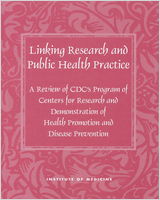NCBI Bookshelf. A service of the National Library of Medicine, National Institutes of Health.
Institute of Medicine (US) Committee to Review the CDC Centers for Research and Demonstration of Health Promotion and Disease Prevention; Stoto MA, Green LW, Bailey LA, editors. Linking Research and Public Health Practice: A Review of CDC's Program of Centers for Research and Demonstration of Health Promotion and Disease Prevention. Washington (DC): National Academies Press (US); 1997.

Linking Research and Public Health Practice: A Review of CDC's Program of Centers for Research and Demonstration of Health Promotion and Disease Prevention.
Show detailsIn 1986, Congress authorized the Centers for Disease Control and Prevention (CDC) to develop a program of university-based research centers to undertake research projects in health promotion and disease prevention and to demonstrate the use of new and innovative research in public health techniques to improve public health. A decade later, after the prevention research center program grew from 3 initial centers to 13, the director of the CDC Division of Adult and Community Health, which oversees the program, requested of the Institute of Medicine (IOM) an evaluation of the overall program. To execute this study, the IOM established the Committee to Review the CDC Centers for Research and Demonstration of Health Promotion and Disease Prevention, which has prepared this report.
The broad mission of the prevention research centers program—to contribute to a fuller understanding of how the health of communities, and the nation, can be improved—can be achieved only through the sustained cooperation of a diverse array of professionals and nonprofessionals who have roles in influencing the health of communities, who have competing goals and priorities, and who have little history of engaging in long-term, cooperative efforts. Consistent with this understanding, the committee took a broad view of how prevention research can influence the health of communities, considering not only the proximal risk factors for disease prevention, but also the more distal conditions for health promotion and improved equity in the distribution of risk factors.
On a practical level, the committee recognized the difficulty of conducting community-based prevention research. The committee examined how a prevention research center could foster collaboration among these different groups and overcome the barriers separating universities from their surrounding communities. It also considered the need for high-quality research that produces research findings relevant to other communities, states, and regions.
The committee brought together expertise in prevention research, behavioral sciences, preventive medicine, clinical medicine, community health, health promotion and education, rural health, health services research, research administration, evaluation sciences, epidemiology, and public health practice at the state and local levels. Committee members met three times between March and July 1996. CDC staff and some of those who advocated for the program while it was being considered by the Congress joined the committee for its first meeting.
In addition to its regular meetings, members of the committee and its staff conducted site visits to prevention research centers in New York, North Carolina, and New Mexico, and to the CDC offices in Atlanta responsible for the direction and funding of the program. The director of the prevention research center at the University of Washington met with the committee during its July meeting. Telephone interviews, following detailed review of documents and written responses, were conducted with senior staff of the remaining nine centers. Informal contacts were made with others, including public health officials in the states and localities in which the centers are located. The site visits, meetings, reports, and telephone interviews gave the committee the opportunity to discuss important issues with prevention research center researchers and their collaborators, such as the challenges of developing innovative research projects, conducting demonstration projects in underserved communities, improving public health practices, and disseminating research findings.
The committee is grateful for the input it received from many individuals at its meetings, during site visits, in writing, and in other ways. The prevention research center directors and co-directors and the CDC staff who responded to the committee's surveys and participated in site visits are listed in Appendix C. Bo Barrow, Don Benken, Roger Bulger, Michael Eriksen, Patricia Evans, Michael Gemmell, D.A. Henderson, Martha Katz, Lloyd Kolbe, James Marks, David McQueen, Gil Omenn, and Jean Smith participated in the committee's meetings or provided information for the committee. Patricia Riley, the CDC program director, was especially generous of her time and energy. The committee also thanks the IOM staff responsible for the project, including Linda Bailey, who was responsible for organizing the committee's meeting, site visits, and interviews, and for background research and writing; Donna Thompson, for project assistance; Marnie Muscoplat and Kimberly Tremel, who provided research support; and Michael Stoto, the director of the IOM Division of Health Promotion and Disease Prevention, in which this project was housed.
In this report the committee concludes that the CDC prevention research centers program has had substantial progress and its participants are to be commended for its contributions to health promotion and disease prevention. The report proposes a set of recommendations intended to strengthen the quality and management of the program as it begins its second decade of work. By strengthening the program, the prevention research centers can contribute even more to local, state, and national efforts to improve the health of Americans.
Lawrence W. Green, Chair
- Preface - Linking Research and Public Health PracticePreface - Linking Research and Public Health Practice
Your browsing activity is empty.
Activity recording is turned off.
See more...